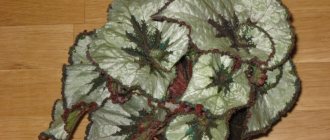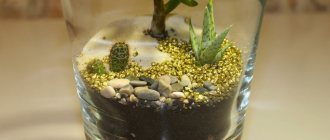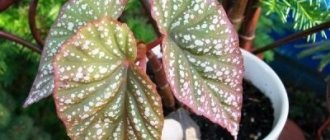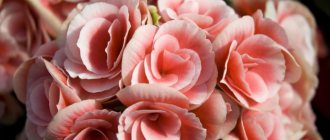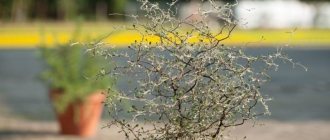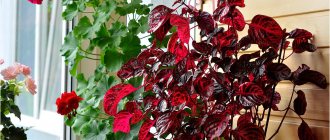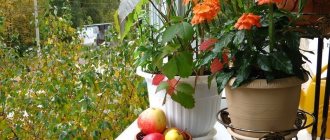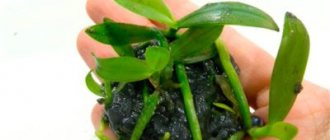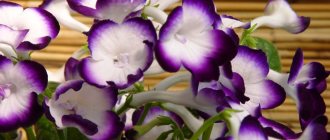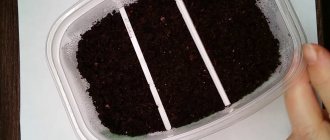Good afternoon, my dear readers. Today I again admired my beautiful begonia, but before I was quite skeptical about such plants. For understanding, let me clarify: we are talking about the Rex variety, which belongs to the group of decorative deciduous begonias, which have gained popularity precisely because of their magnificent greenery.
The flowers of such species are inconspicuous, but beautiful lush leaves successfully provide an alternative to them. Caring for them at home is not difficult, but the magnificent multi-colored greenery (and experts count up to 900 species) will bring you joy and positivity and will become a real decoration in the interior of your home.
Where does begonia grow best?
The homeland of this beautiful plant is the tropics and subtropics of Africa and South America, respectively, and when grown indoors they need to create similar conditions.
Begonia loves light, but does not tolerate direct, burning rays of the sun. Keep this in mind when planning the placement of flower pots, because one of the common mistakes of novice gardeners is placing plants in the sun. All three cardinal directions, excluding the fourth - the south, are suitable for begonias, so you can always find a place for the plant in the apartment.
IMPORTANT! Begonia, like many other flowers, does not like drafts, so care must be taken to ensure that these unpleasant phenomena are absent.
Popular types and varieties
There are more than 1,000 varieties of begonias, both outdoor and indoor. The most popular include the following.
- Cane begonias are bushy or reed-like plants, distinguished by an erect stem, rather beautiful leaves and flowers with a delicate fragrant aroma. Such flowers reach a height of 2 m, so they are most often grown in greenhouses and winter gardens.
- Royal begonias are herbaceous plants with lacy multi-colored leaves, thick stems and creeping fleshy roots.
- Ever-flowering - they are quite compact bushes, the leaves are waxy, can be painted in a variety of shades, in the conditions of central Russia they are cultivated as garden annuals.
- Tuberose is a fairly unpretentious variety with beautiful large flowers.
Many varieties and varieties of begonia are adapted for living at home. Among the most popular begonias in indoor floriculture, the following varieties should be noted.
- “Mason” is a fairly compact begonia, the peculiarity of which is pimply green leaves with a purple spot that visually resembles a Maltese cross - this color makes the flower very decorative and impressive. The leaf blade is asymmetrical, heart-shaped . The roots are of a creeping type, thickened and covered with numerous hairs.
The leaves form a lush bush about 20-30 cm high, although if comfortable living conditions are maintained, the plant can grow up to 50 cm. The flowers are small and inexpressive.
- Begonia “Bauer” is a very small indoor plant, only 10 cm high, the leaves are heart-shaped, velvety, the edges are rounded, their color looks very unusual: against a dark, almost black background, light green spots shimmering with bronze stand out sharply, the edge is framed by milky white cilia , and the veins are very clearly drawn. Leaf cuttings are red in color. In spring, flower stalks appear from the rhizome.
- Begonia collarata is another rather interesting house begonia. This is a very unpretentious variety, the peculiarity of which is large light green leaves, the diameter of which reaches 30 cm. The foliage forms a rather lush and spreading bush, the plates along the edges are cut and covered with small villi, the upper part is glossy, and the lower part is covered with “cilia”. At the point where the cuttings are attached to the leaves, a kind of “cuff” is formed from red hairs , which is why the plant got its name.
- Red-leaved begonia - this plant is known to many gardeners under the name “Fiesta”; it has a slightly shortened stem, long cuttings and round, slightly colored leaves. The surface of the leaf plate is smooth, dense, almost glossy. The front side of the leaf is green, the back is painted red, with well-drawn white veins. Flowering is observed from December until spring.
- Begonia hogweed is one of the most popular plants in home gardening. It is characterized by large palmately dissected leaf blades with sharp serrated edges and a heart-shaped base. The leaves are colored relatively evenly, silver-gray veins are distributed over the entire surface, while the saturation of the shade depends on the level of lighting. The inflorescences are enlarged, but inconspicuous.
- Spotted begonia is a bush begonia, characterized by an erect stem, in favorable conditions it can reach several meters, therefore it is grown, as a rule, in greenhouses. The leaves are elongated, asymmetrical, the apex is pointed. The leaves visually resemble angel wings in their shape , which is what the plant was called in the time of our grandmothers. The surface of the leaf plate is glossy, very dense, the color (deep green) is literally dotted with white veins. The back side is reddish-red.
Room temperature
It is necessary to ensure a stable air temperature so that there are no sudden changes. You should also monitor the level of humidity, after all, this “miracle” comes from the tropics, and therefore dry air has a detrimental effect on the growth, condition and color of the leaves.
In this case, it is necessary to comply with the norm and avoid overmoistening, otherwise the begonia branches will begin to rot. The best option for winter, when operating heating systems “dry” the air, is to place flower pots in a tray with slightly moistened sphagnum or gravel.
Spraying is useful, but it must be done carefully and correctly so that drops of water do not fall on the leaves, but form a cloud around the plant. Only heated, settled or filtered water is used.
Your room will have a constant temperature and normal humidity, the begonia leaves will be rich in color, bright, and beautiful.
Let's talk about watering
From spraying, let's move on to the related topic of watering plants. In order for begonia to delight you with lush foliage, it is best to water it through a tray. In this case, you can avoid getting water on the surface of the beautiful carved leaves and over-moistening the earthen ball in the pot.
In winter, water moderately, in spring and summer - abundantly, avoiding stagnation of water.
Transfer
The basic rule is that the container where begonia grows should not be too spacious for it. This species grows better in small pots, but when replanting you need to take a pot a little larger (about a centimeter or two) than the previous one. Soil for decorative leaf begonia is a nutrient substrate, the main components of which are:
- peat;
- humus;
- deciduous soil;
- sand.
When the begonia “moves” to a new place, the earthen lump must be kept intact. This is especially important for decorative deciduous species, otherwise the greenery of the plant will lose its lushness and elasticity.
Rules of care
Begonia is a rather unpretentious indoor plant, but in order for it to continue to delight its owners with its decorative appearance for many years, the flower should be provided with comfortable living conditions.
Landing
Planting and replanting work with begonia should be carried out at the very beginning of spring , when the plant is just awakening from the winter period and begins to actively grow. The fact is that placing it in new soil stops the development of the flower for some time, since the plant experiences severe stress from the changed living conditions. This must also be taken into account when buying a new flower - store-bought begonias have been growing for a long time in greenhouse conditions in compliance with all the rules of agricultural technology and optimal living conditions, but at home the plants are forced to adapt to the new environment.
The soil for planting should be slightly acidic, almost neutral, fertile, with high parameters of water and air permeability. You can purchase ready-made soil mixture, or you can assemble it yourself. To do this, humus and leaf soil are mixed in equal parts , disinfected, and then river sand and perlite are added.
The container for indoor begonia should be shallow but wide. The root system of this flower is superficial, so if the container is too large, then waterlogging will begin in the layers of the earth where there are no roots, which is very detrimental to the plant.
The material of the pot can be anything; it is very important to provide an effective drainage system that will allow all excess water to be removed.
"Baby Dress" is a compact rhizome begonia. This beauty has rather large leaves of a juicy golden-green color on short petioles, twisted into a double snail at the base. The edge of the sheet is decorated with a contrasting red-brown ruffle and touching fibers.
Begonia “Baby Dress” brings a sunny spring mood to your window.
Begonia "Benitochiba" - obtained by crossing Begonia rex "Filigree" (Begonia rex) and Begonia luxurians. Bush-like form with beautiful maple leaves. Green-violet veins are clearly visible on the pearl-silver background. The edge of the leaf has a pearlescent pink tint. This hybrid begonia does not stretch upward and is densely leafy.
Like royal begonias, "Benitochiba" prefers bright, diffused light, but it does not need high air humidity.
Begonia "Black Fang". Compact rhizome variety. The leaves are velvety burgundy-black with a deeply indented edge, with bright light green veins running from the center. The base of the leaf blade is twisted into a double snail.
This variety will decorate any collection!
Decorative deciduous begonia “Charlotte Chiffon” is one of the most spectacular and delicate varieties. The leaf is pearlescent-silver, with a pink-lilac spot in the center of the leaf. The edge of the leaf is wavy, the border is bright pink. This variety bushes well.
Sometimes the begonia "Charlotte Chiffon" is sold under the name Pinkpop .
Begonia rex "Charm". The leaves are large, rounded, slightly toothed. The base of the leaf is spirally twisted. The center and edges are dark brown, along the middle of the leaf there is a wide bright green stripe covered with thick silver specks. The delicate peach flowers are quite large and very pretty.
Gorgeous bright plant!
Royal begonia 'Chocolate Cream' is one of the most beautiful hybrid begonias. The leaf is rounded with a sharp tip, slightly toothed, and twisted into two spirals at the base of the leaf. The center of the leaf, the veins and the fringed edge of the leaf are a bright dark brown color. The middle stripe is light green-silver, the edges of this stripe are silvery-pink.
"Dewdrops" is a compact rhizome begonia. Rounded foliage of medium size, satiny, pearlescent-smoky, at the base the leaf is twisted into a snail. The greyish-green veins on the leaves spread out in matte “spiders”. Along the edge of the leaf there is a narrow, darker border.
Begonia "Dewdrops" grows in a neat fluffy bush.
Begonia rex "Dollar Down" is a miniature begonia with bright scarlet-red leaves framed by a brownish-black border.
Royal Begonia "Fireworks" is one of the most beautiful decorative foliage begonias. The central part of the leaf is black-violet, turning into dark green. On a dark green background there is a pattern of thin dark brown veins and silvery spots. Along the edge of the leaf there is a wide brown border with a purple tint.
The beauty of the leaves of this wonderful begonia is mesmerizing!
Begonia "Five and Dime" is a compact rhizome variety. The leaf is rounded with a wavy edge and a spiral base. The surface of the leaf is pearlescent smoky pink, along the edge of the leaf there is a thin black-green edging.
Royal Begonia "Green Gold" is a real beauty. Large rounded leaves with a sharp tip are twisted into a steep spiral. In the center of the leaf is a spider made of bright green veins. The leaf itself is silver with a greenish-blue tint, and the edge of the leaf is decorated with a thin brown ruffle.
The leaf petioles are short, giving this variety a compact appearance.
"Gryphon" is a new hybrid of the royal begonia. It reaches more than 40 cm in height and width. The leaves are large, maple-shaped, serrated, strongly dissected, dark green with silver strokes between the veins.
Unlike rex begonias, the hybrid Griffon begonia is more hardy and is not so demanding on watering and air humidity.
Begonia rex 'Hallelujah' has large foliage with a slightly curling center. The center and edge of the leaf are black currant in color. There is a wide silver stripe between the center and edge. The leaves are quite large, but the plant is compact and does not stretch.
Spectacular and luxurious variety!
'Helen Lewis' is a vibrant begonia with large, velvety leaves. The edge of the leaf and the center of the leaf are brown-cherry in color, between them there is a wide silver and thin bright green stripe.
Begonia will decorate any collection.
Royal begonia "Lillian" has large emerald leaves covered with silver spots, with a pink tint at the base. Along the edge of the leaf there is a wide wavy border the color of dark chocolate. Double shell. One of my favorite varieties!
How to propagate begonia?
Do you really want to increase the number of these beautiful plants in your home? Then you need to know everything about the methods of propagating begonias in order to choose the most suitable ones for yourself.
IMPORTANT! Decorative deciduous begonia must be constantly renewed and this is best done with the help of cuttings.
Reproduction methods:
- seeds (material for planting is purchased at flower shops);
- leaves;
- stem cuttings.
One leaf, two leaves
The leaf propagation method is one of the most popular and simplest, and I grew my own begonia from just such a leaf.
To do this, you need to select a leaf on the plant, carefully cut it, let the cut dry slightly, and then plant the leaf in a prepared container with substrate. Some gardeners first put the leaf in water, wait for small roots, and then plant it in the ground.
Reproduction by stem
Propagation of begonia by stem cuttings gives good results; for this you need to select either young shoots or already slightly lignified parts. Prerequisite: presence of kidneys.
Leaves are removed from the cuttings, an oblique cut is made and placed in prepared pots with substrate. It is advisable to cover the top of the cuttings with film, but be sure to remove it for ventilation and watering. It is the film that will create the necessary greenhouse microclimate for begonias, and they will quickly take root. But as soon as the plants get stronger, the film must be removed so that the begonias can adapt to the room temperature.
IMPORTANT! Decorative deciduous begonia needs regular renewal, in which case you will always have beautiful plants with spectacular greenery.
Reproduction
Begonias are propagated by stem cuttings, leaves, part of a leaf, division and seeds. For cuttings, you need to cut the tops of branches about 15 cm long from small-leaved begonias, or a piece of stem with one or two leaves from large-leaved begonias. Cuttings can be rooted in water; roots appear within a week or two. When they grow 4-5 cm long, they can be pressed into pots.
By the way, in rhizome begonias, it is enough to cut off pieces 2-4 cm long from the rhizome and place them in bowls for rooting, preferably with soil heating, or in warm times, when the soil temperature is not lower than 25-26 ° C.
This begonia gets little light (the bush is loose, the petioles are long), and salt deposits are visible on the soil.
If you water begonias without allowing the soil to dry out, such spots appear on the leaves, the petioles and stems rot.
Young rooted begonias should be planted in porous, well-drained soil.
You need to know the enemy
The list of “opponents” of begonia should include:
- dry air (we described in detail how to water and spray);
- powdery mildew;
- mold;
- gray rot;
- aphid;
- poutine mite.
To be fair, let’s say that these plants are quite unpretentious, they are resistant to diseases and pests, but if some kind of misfortune occurs, then improper care and non-compliance with the regime are most often to blame.
Mold and powdery mildew are removed with special compounds, after removing all plaque from the leaves. But in the fight against pests, infusions of ordinary garlic, chamomile or tobacco help well.
I think you are convinced that not much effort is required when growing begonias, but this flower will thank you with its magnificent colorful greenery.
